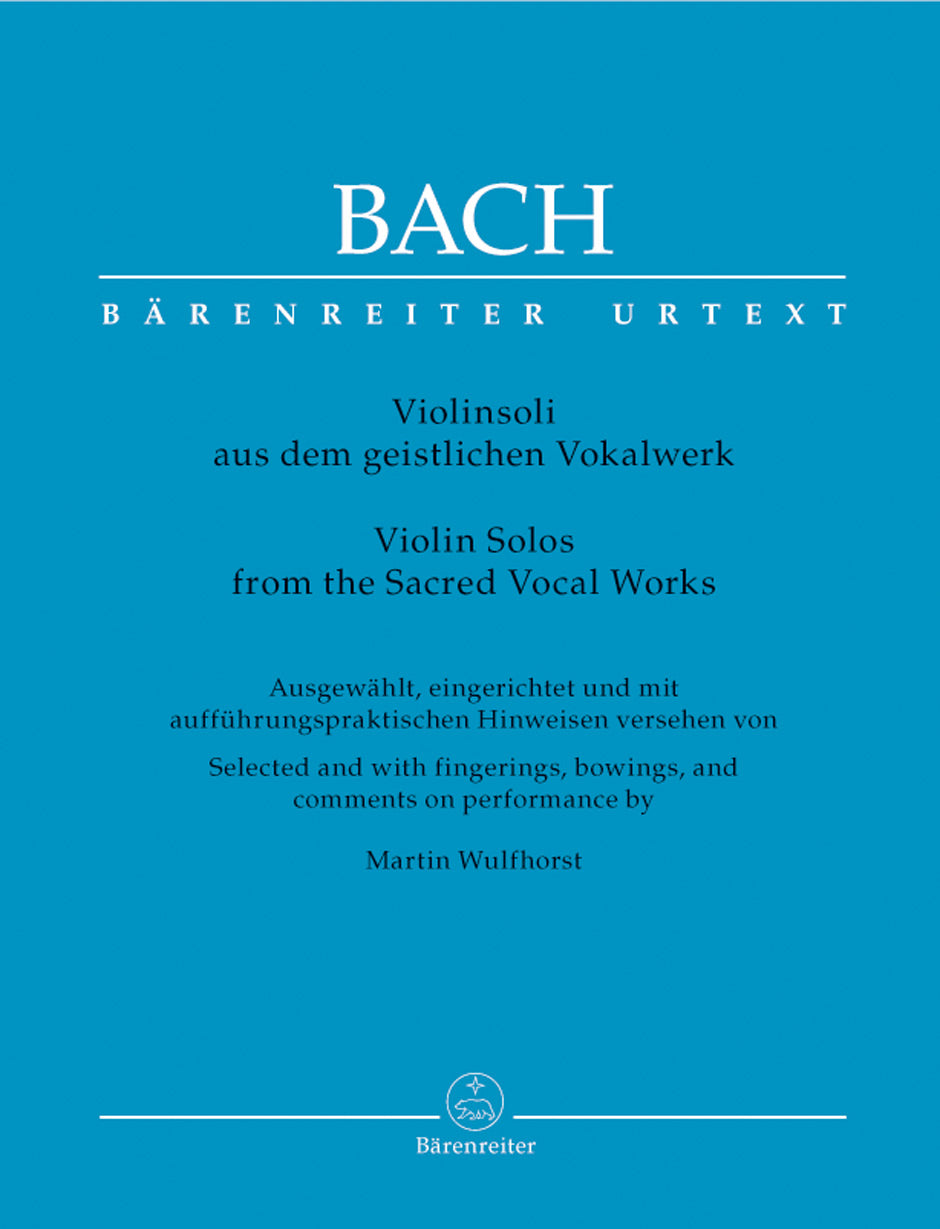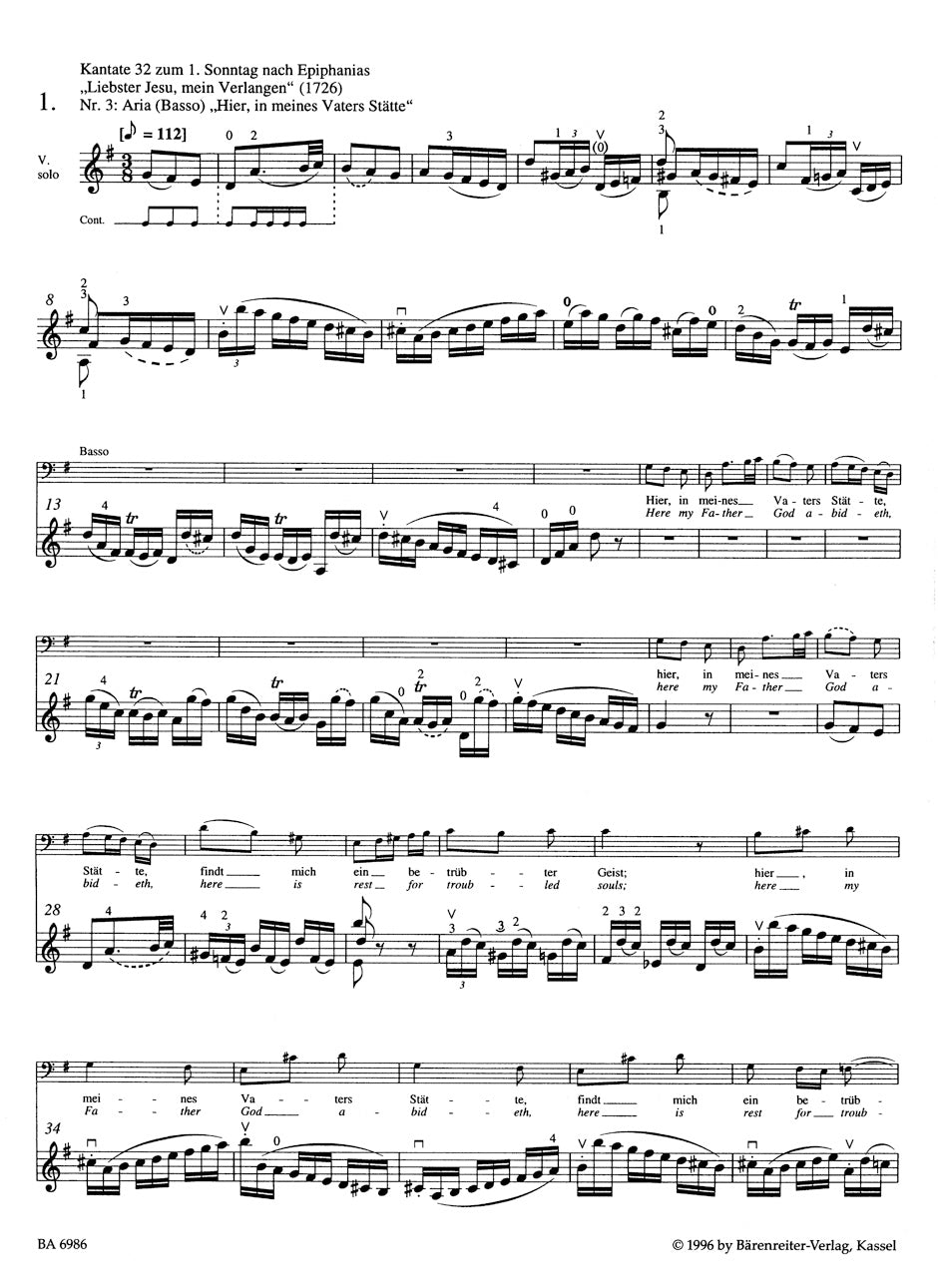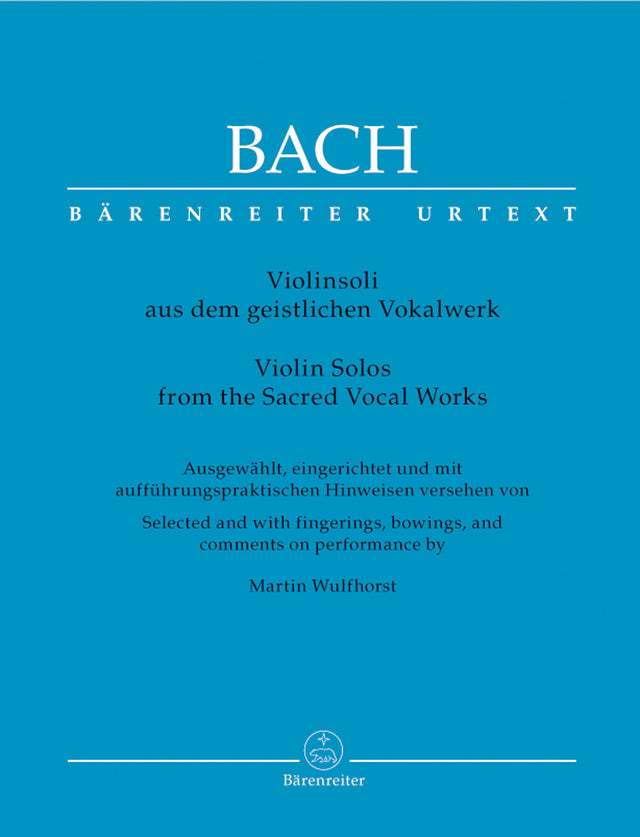Bach: Violin Solos from the Sacred Vocal Works
In stock and typically ships within 1 business day.
- Composer: Johann Sebastian Bach (1685-1750)
- Editor: Martin Wulfhorst
- Instrumentation: Violin
- ISMN:
- Size: 9.4 x 12.2 inches
- Pages: 78
- Urtext / Critical Edition
Description
Bach employed one or two solo violins in most of his sacred vocal works. However, although these works have a firm place in the musical life of our time, the solo passages and movements they contain are generally not considered fully-fledged items of the violin repertoire, whether in teaching or in performance. The object of the present collection is to serve violinists both as a study edition and as an instrumental part for performing purposes, not only providing a reliable musical text based on the Urtext of the New Bach Edition (NBA), but also making available all the information necessary to project the meaning of the words so that violinists can do justice to the multifarious challenges posed by Bach's solos for violin.
As an aid to the interpretation of these violin solos, the collection richly annotated with fingerings and articulation markings offers not only the violin part but also the complete vocal part for each movement.
Contents:
- Einführung, Zeichenerklärung (deutsch/englisch)
- Kantate BWV 32 Liebster Jesu, mein Verlangen; No. 3 Arie (Bass): Hier, in meinesVaters Stätte
- Kantate BWV 51 Jauchzet Gott in allen Landen; No. 4 Choral (Sopran): Sei Lob and Preis mit Ehren (mit Violin II)
- KantateBWV 57 Selig sei der Mann; No. 7 Arie (Sopran): Ich ende behende mein irdisches Leben
- Kantate BWV 147 Herz and Mund and Tat and Leben, No. 5 Arie (Sopran): Bereite dir, Jesu, noch itzo die Bahn
- Kantate BWV 74 Wer mich liebet, der wird mein Wort halten; No. 7 Arie (Alt): Nichts kann mich erretten von höllischen Ketten
- Kantate BWV 86 Wahrlich, wahrlich, ich sage euch; No. 2 Arie (Alt): Ich will doch wohl Rosen brechen
- Kantate BWV 97 in allen meinen Taten; No. 4/4 Arie (Tenor): Ich traue seiner Gnade
- Kantate BWV 108 Es ist euch gut, dass ich hingehe; No. 2 Arie (Tenor): Mich kann kein Zweifel stören
- Kantate BWV 120 Gott, man lobet dich in der Stille; No. 4 Arie (Sopran): Heil and Segen soll and muss zu aller Zeit
- Kantate BWV 140 Wachet auf, ruft uns die Stimme; No. 3 Duett (Sopran/Bass): Wenn kömmst du, mein Heil
- Kantate BWV 158 Der Friede sei mit dir; No. 2 Arie mit Choral (Sopran/Bass): Welt ade, ich bin dein müde
- Kantate BWV 171 Gott, wie dein Name, so ist auch dein Ruhm; No. 4 Arie (Sopran): Jesus soll mein erstes Wort
- Messe in B Minor BWV 232; No. 6 (Gloria): Laudamus te (Sopran)
- Matthäus-Passion BWV 244; No. 39 Arie (Alt): Erbarme dich
- Matthäus-Passion BWV 244; No. 42 Arie (Bass): Gebt mir meinen Jesum wieder
- Weihnachtsoratorium BWV 248/III; No. 31 Arie (Alt): Schließe mein Herze
- Weihnachtsoratorium BWV 248/V; No. 51 Terzett (Sopran/Alt/Tenor): Ach, wenn wird die Zeit erscheinen
- Weihnachtsoratorium BWV 248/IV; No. 41 Arie(Tenor): Ich will nur dir zu Ehren leben (mit Violin II)
- Weihnachtsoratorium BWV 248 / IV; No. 41 Arie (Tenor): Ich will nur dir zu Ehren leben (mit Violin II)
Publishers use a lot of words to describe what they sell, and we know it can be confusing. We've tried to be as clear as possible to make sure you get exactly what you are looking for. Below are descriptions of the terms that we use to describe the various formats that music often comes in.
Choral Score
A score for vocalists that only contains the vocal lines. The instrumental parts are not there for reference. Generally, cheaper than a vocal score and requires multiple copies for purchase.
Facsimile
Reproductions of the original hand-written scores from the composer.
Full Score
For ensemble music, this indicates that the edition contains all parts on a single system (there are not separate parts for each player). In larger ensembles, this is for the conductor.
Hardcover
Hardbound. Generally either linen-covered or half-leather.
Orchestral Parts
Similar to a wind set, this is a collection of parts. In the case of strings, the numbers listed are the number of copies included, though generally these are available individually (often with minimum quantities required).
Paperback
When publishers offer multiple bindings (e.g. hardcover) or study scores, this is the "standard" version. If you're planning to play the music, this is probably what you want.
Performance / Playing Score
A score of the music containing all parts on one system, intended for players to share. There are not separate parts for each player.
Set of Parts
For ensemble music, this indicates that there are separate individual parts for each player.
Solo Part with Piano Reduction
For solo pieces with orchestra, this is a version that contains a piano reduction of the orchestra parts. For piano pieces, two copies are typically needed for performance.
Study Score
A small (think choral size) copy of the complete score meant for studying, and not playing. They make great add-ons when learning concertos and small chamber works.
Vocal Score
A score prepared for vocalists that includes the piano/organ part or a reduction of the instrumental parts.
Wind Set
For orchestral music, this is a collection of wind and percussion parts. The specific quantities of each instrument are notated.
With Audio
In addition to the printed music, the edition contains recordings of the pieces. This may be an included CD, or access to files on the internet.
With / Without Fingering (Markings)
Some publishers prepare two copies - a pure Urtext edition that includes no fingering (or bowing) suggestions and a lightly edited version that includes a minimal number of editorial markings.




